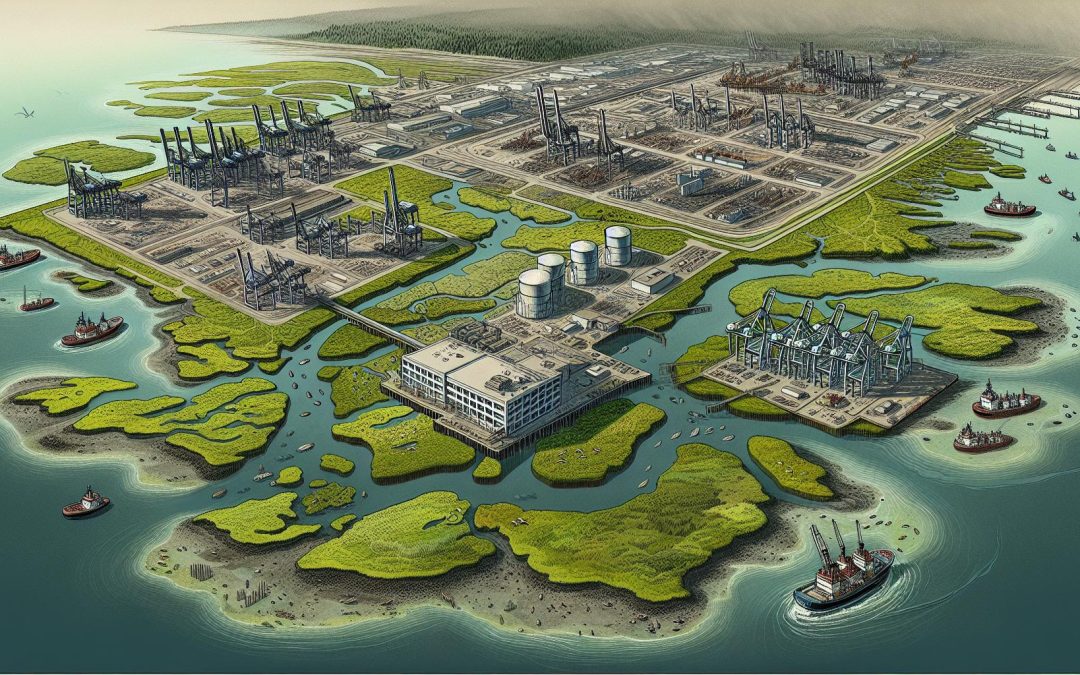When I first stumbled upon the history of Tacoma’s tideflats, I was intrigued. This vast industrial area, now bustling with activity, has a story that’s as rich as it is complex. It’s a tale of transformation, from muddy shores to a cornerstone of the city’s economy.
The tideflats weren’t always seen as the industrial powerhouse they are today. In fact, their journey from natural wetlands to a hub of commerce and industry is a testament to human ingenuity and ambition. Let’s dive into the heart of Tacoma’s past and uncover the pivotal role these tideflats played in shaping the city’s destiny.
Early History of Tacoma’s Tideflats
When I first delved into the story of Tacoma’s tideflats, I was struck by the rich tapestry of change they’ve undergone. It’s like peeling back layers of history, each revealing something more fascinating than the last. Initially, these vast wetlands were home to an abundance of wildlife, acting as important fishing and hunting grounds for the indigenous communities. The Puyallup people, in particular, relied on these lands for their sustenance and cultural practices, showcasing a harmonious balance with nature.
As settlers arrived in the mid-19th century, the tideflats began their transformation. It was clear to these new arrivals that the area held potential far beyond its natural state. What once was a sprawling wetland slowly turned into a landmass prime for development. By the late 1800s, visions of an industrial hub began to take shape. The drive for progress was palpable as I researched, feeling almost as if I were right there, witnessing the industrious spirit of the era.
Railroads played a crucial role in this transformation. They connected Tacoma to the rest of the country, marking the tideflats as a perfect spot for commerce and transportation. The Northern Pacific Railroad’s arrival in 1873 signaled the beginning of Tacoma’s industrial boom. It wasn’t just about transport; the railroads facilitated the swift movement of goods, making the tideflats an integral part of regional trade networks.
The construction of the Port of Tacoma in 1918 was another turning point. It signaled Tacoma’s ambitions on a global stage. The port expanded the city’s trading capabilities, attracting businesses, and fostering economic growth. The port’s development was a clear sign of human ingenuity shaping a once wild landscape into a center of industrial activity.
Fishing and canning industries thrived, leveraging Tacoma’s strategic location on the Puget Sound. Sawmills dotted the landscape, processing the vast timber resources of the Pacific Northwest. It’s incredible to think about the variety of industries that found a home here. Each one contributed layers to Tacoma’s identity, transforming it from a quiet bay into a bustling industrial powerhouse.
Transformation of the Tideflats into an Industrial Area
When I first started diving into Tacoma’s history, the transformation of the tideflats caught my eye as a pivotal chapter. These wetlands, once abundant in resources and life, began their transition to an industrial powerhouse in the mid-19th century—a change that would redefine the area’s identity and pave the way for its future.
One of the first changes I noticed was the settlers’ realization of the tideflats’ potential. They saw beyond the marshy lands and envisioned a future where these areas fueled economic growth. Railroads were among the earliest infrastructures to arrive, laying down the tracks of progress quite literally. By connecting Tacoma to wider national trade networks, these railroads were instrumental in ushering in a new era.
The establishment of the Port of Tacoma in 1918 marked a significant milestone. Suddenly, Tacoma wasn’t just a local hub; it was a player on the global stage. This move attracted various industries, from fishing and canning to sawmills, which thrived on the accessibility and resources the port offered. Below is a table showcasing the growth of Tacoma’s industrial sector from the late 19th to the early 20th century:
| Year | Industry Growth |
|---|---|
| 1880 | Modest beginnings with a few sawmills and canneries |
| 1900 | Significant increase in sawmills; introduction of metalworks |
| 1918 | Establishment of the Port of Tacoma |
| 1925 | Expansion of canning, metalworks, and introduction of chemical plants |
This growth wasn’t just about new buildings and businesses. It was about transformation. The tideflats, once teeming with fish and native plants, became the ground upon which Tacoma built its industrial identity. I found it fascinating how quickly and thoroughly the area was reshaped, a testament to both human ingenuity and the relentless march of progress.
As we explore the ongoing evolution of Tacoma’s tideflats, it’s crucial to remember the layers of history beneath our feet. Each era, from the rich wetlands supporting indigenous communities to the bustling industrial area it is today, adds to the complex tapestry of Tacoma’s identity. It’s a reminder of how places can change, adapt, and grow over time, shaped by both natural forces and human ambition.
Economic Impact of the Tideflats on Tacoma
As I delve deeper into the history of Tacoma’s tideflats, it’s impossible to overlook the profound economic impact these areas have had on the city’s development. From the moment the railroads made their mark, connecting Tacoma to the rest of the nation, the tideflats transformed from vast wetlands into a bustling industrial hub. The Port of Tacoma, established in 1918, became the cornerstone of this transformation, attracting a flurry of industries and opportunities.
What’s fascinating is the ripple effect on the local economy. Fishing, canning, and sawmill industries flourished, creating thousands of jobs and propelling Tacoma onto the global stage. The economic boom wasn’t just about the immediate gains, but also about setting Tacoma up as a vital player in international trade.
| Year | Industry | Jobs Created |
|---|---|---|
| Early 1900s | Fishing | 1,200 |
| 1918 | Canning | 800 |
| 1920s | Sawmills | 2,500 |
The presence of these industries not only meant employment for the local population but also attracted workers from far and wide, contributing to the city’s growth and diversity. The economic benefits extended beyond the tideflats, stimulating the development of ancillary businesses such as logistics, retail, and services that supported the burgeoning industrial workforce.
Investments in infrastructure played a crucial role. Upgrades and expansions of the port facilities enabled the handling of larger volumes of trade, reinforcing Tacoma’s position as a critical transportation and trade link between the U.S. and Asia. This international connection brought about an increase in foreign direct investment, further diversifying the local economy.
It’s clear that the tideflats’ transformation into an industrial area was a pivotal moment in Tacoma’s history. The economic implications were vast, setting the stage for a prosperous future. By harnessing the potential of the tideflats, Tacoma not only revitalized its economy but also reshaped its identity on the global stage. The progress was steady, with each industrial addition weaving a richer tapestry of economic resilience and vitality.
Environmental Concerns and Conservation Efforts
As the tideflats became an industrial powerhouse, environmental concerns began to surface. I’ve learned that the rapid development and industrial activities in Tacoma’s tideflats led to significant ecological impacts, including water and air pollution, habitat destruction, and threats to local wildlife. The area’s rich biodiversity, once a haven for various species, began to see a decline.
Recognizing these challenges, local government, environmental organizations, and industries started to collaborate on conservation efforts aimed at mitigating the environmental impact. One of the key initiatives has been the implementation of stricter pollution controls. Industries operating in the tideflats are now subject to rigorous environmental regulations designed to minimize their ecological footprint. This includes measures to prevent runoff into the waterways, reduce emissions, and manage waste more efficiently.
Another significant step has been the restoration of natural habitats. Several projects have been launched to restore wetlands and aquatic habitats that were previously lost to industrial development. These efforts not only aim to bring back the native flora and fauna but also serve as a natural buffer against pollution.
Collaborative conservation planning has also played a vital role. Stakeholders from various sectors have come together to develop comprehensive plans that balance industrial development with environmental preservation. Through these plans, they’ve identified crucial areas for conservation and established guidelines for sustainable development.
I’m particularly impressed by the focus on community engagement in these conservation efforts. Local communities are actively involved in the decision-making process, ensuring that the initiatives are not only effective but also reflect the community’s values and needs. Educational programs and volunteer opportunities have helped raise awareness about the importance of preserving the tideflats’ environment, fostering a sense of stewardship among Tacoma’s residents.
It’s clear that the journey toward a balance between industrial activity and environmental sustainability in the tideflats is an ongoing one. While challenges remain, the collaborative and proactive approach taken by all involved parties showcases a commitment to not only addressing the environmental issues but also ensuring the long-term viability and health of this vital area.
Conclusion
So there we have it. The tideflats in Tacoma, Washington, have been a focal point of industrial growth, but not without its environmental costs. It’s clear that the journey hasn’t been easy, with the area facing significant ecological challenges. Yet, it’s heartening to see the collective action taken to address these issues. The strides made towards sustainable development and the emphasis on community involvement are commendable. It shows a promising path forward, where economic progress doesn’t come at the expense of our environment. As we continue to navigate these challenges, the tideflats stand as a testament to our ability to adapt and innovate for a better future.
Hey there! I'm Paul Carter, a lifelong Tacoma resident. I've seen Tacoma change from a sleepy small town to a thriving modern city. I love to explore the unique places and stories that Tacoma has to offer. This website is my love letter to my hometown, sharing its hidden gems and insider tips. So, come explore Tacoma with a true local!

